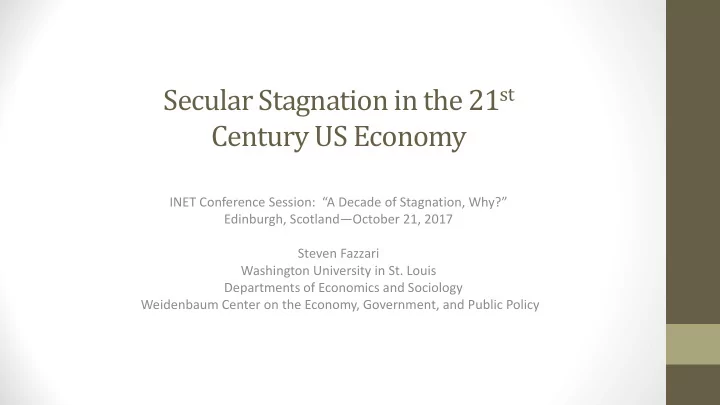

Secular Stagnation in the 21 st Century US Economy INET Conference Session: “A Decade of Stagnation, Why?” Edinburgh, Scotland—October 21, 2017 Steven Fazzari Washington University in St. Louis Departments of Economics and Sociology Weidenbaum Center on the Economy, Government, and Public Policy
A Decade of U.S. “Secular Stagnation” • Summary of presentation • Headline data: stagnation in aftermath of the Great Recession • Theoretical debate: supply-side vs. demand-side • Empirical case: it’s not supply, it’s demand • Rising inequality and demand-side stagnation • Acknowledgements • Support from INET • Co-authored work with Barry Cynamon
Recent Stagnation (Peak-to-peak growth of real GDP per capita) Peak Dates Growth per Year (per capita) 1.8% 1973:4 to 1979:3 1979:3 to 1990:2 2.1% 1990:2 to 2000:2 2.2% 2000:4 to 2007:4 1.4% 0.6% 2007:4 to 2017:2* *Final cycle is incomplete
Stagnation: Supply-Side Theoretical Lens • Mainstream theory: Keynesian demand problems relevant only in the “short run;” supply side rules the long run • The neoclassical synthesis • Old version: wage and price adjustment • New version: wise monetary policy • Persistent stagnation • 10 years since peak; 8 years since trough • Beyond the short run, therefore, problems must be with supply
Stagnation: Demand-Side Theoretical Lens • Critique of the neoclassical synthesis • Destabilizing effects of deflation and disinflation • Can we rely on monetary policy? • Low interest elasticities of consumption and investment • If monetary policy works, it creates financial instability (Minsky) • If a “natural rate” exists, it is likely volatile and often negative • Zero lower bound not the main issue • No endogenous market or policy mechanism to restore demand to potential output “beyond the short run” • Demand growth dynamics are the engine of economic activity most of the time • Look at the evidence …
Weak Evidence for Supply-Side Stagnation • Paper discusses some detailed evidence • More slack in the labor market than suggested by low unemployment rate • Business investment not particularly low given slow growth • Key test: supply-side stagnation should cause high real interest rates
Real Interest Rates: No Evidence of Supply Stagnation 6.00 5.00 4.00 3.00 2.00 1.00 0.00 1990 1992 1994 1996 1998 2000 2002 2004 2006 2008 2010 2012 2014 2016 -1.00 10-Year T Bond - Core PCE Infl 5-Year T Bond - Core PCE Infl 10-Year TIPS Real Yield
The Demand Side: Household Demand (Adjusted household demand based on Cynamon & Fazzari, 2017) 11500 2016 Gap: 11000 21.7% 10500 $2.3 trillion 10000 9500 9000 8500 8000 Trend re-joined in past cycles 7500 7000 6500 6000 5500 Unsustainable finance, but we needed this demand 5000 4500 4000 1990 1992 1994 1996 1998 2000 2002 2004 2006 2008 2010 2012 2014 2016 Real Adjusted Household Demand 2000-2006 Trend (HH Dem)
Weak Household Spending and the Stagnant Recovery (Based on Cynamon-Fazzari Review of Income & Wealth, 2017) Real Household Demand Profiles (Population Adjusted) 130.0 125.0 120.0 115.0 Index Peak=100 110.0 1978-1989 105.0 1989-2000 100.0 2000-2006 95.0 2006-2015 90.0 Current cycle has not recovered 85.0 peak value after 10 years! 80.0 1 2 3 4 5 6 7 8 9 10 11 12 Years Since Peak
Government Demand Did Not Replace Households 6000.00 5500.00 5000.00 4500.00 4000.00 3500.00 3000.00 2500.00 2000.00 1500.00 1990 1992 1994 1996 1998 2000 2002 2004 2006 2008 2010 2012 2014 2016 Total Government Consumption, Investment, & Medical 2000-2006 Trend
Nuanced Role for Inequality • Rising inequality as explanation for stagnant demand • Rich spend or “recycle” a smaller share of income than others • But, timing problem • Borrow-and-spend era postpones demand drag • Great Recession forces middle-class demand down • Now more in line with stagnant incomes • But we needed that demand • Inequality can explain at least 10% slowdown of demand path since mid 1980s (Cynamon & Fazzari, EJEEP, 2015)
Consequences • Disappointing “recovery” and secular stagnation “beyond the short run” • Demand leads supply: reverse Say’s Law • Deleveraging not enough to restore robust demand growth • Does not address root cause of rising income inequality • Inconsistent calls for smaller government without addressing demand gap • What engine of demand growth? • New research on household sustainability not optimistic • Recovery relies in large part on spending of the affluent
The Affluent as Growth Engine? Index of Real Consumption, Bottom 95% and Top 5% (1989=100) 260 240 220 200 180 160 140 120 100 80 1989 1990 1991 1992 1993 1994 1995 1996 1997 1998 1999 2000 2001 2002 2003 2004 2005 2006 2007 2008 2009 2010 2011 2012 Bottom 95% Top 5%
Recommend
More recommend